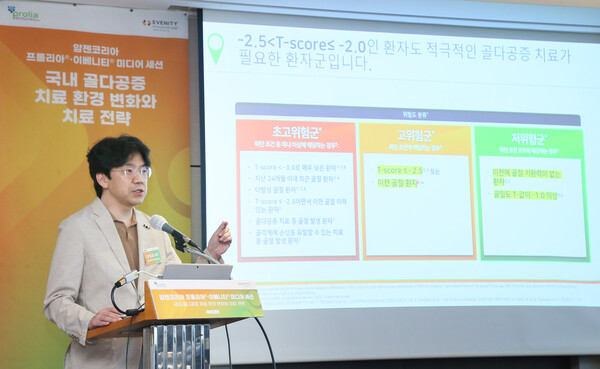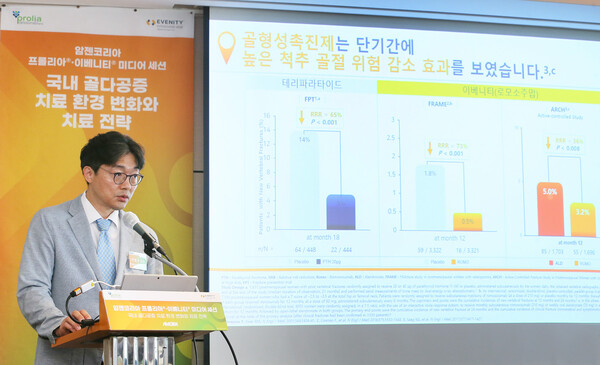Local experts are advocating for an improved treatment environment for osteoporosis patients, emphasizing the importance of continuous medication to minimize fracture risks.
During a recent media session hosted by Amgen Korea at Lotte Hotel in Seoul, specialists discussed the impact of the new reimbursement criteria for osteoporosis treatments, such as Amgen's Prolia (ingredient: denosumab), in treating osteoporosis.
The session comes after the Ministry of Health and Welfare expanded the reimbursement period for major osteoporosis treatments on May 1.
Previously, coverage was limited to patients with a bone density T-Score of -2.5 or lower. The revised criteria now extend coverage to patients with T-Scores between -2.5 and -2.0 for up to two years, facilitating broader access too necessary medications.
Medical professionals, including those from the Korean Society for Bone and Mineral Research, have long argued for this expansion.
Despite a rising number of osteoporosis-related fractures each year, only 36 percent of patients receive osteoporosis medication within a year of their first fracture. Osteoporosis, characterized by the gradual loss of bone density, can lead to fractures from minor impacts, particularly in the spine, femur, and wrists. The disease often goes untreated due to its asymptomatic nature and previously restrictive reimbursement criteria.

Professor Kim Beom-jun of the Department of Endocrinology and Metabolism discussed the risks of osteoporosis-related fractures and the necessity of long-term treatment.
"Bone density naturally decreases with aging, and this process accelerates tenfold during menopause," Kim said. "Osteoporosis, though a chronic disease requiring continuous treatment, sees a significantly lower treatment continuation rate compared to other chronic diseases like diabetes."
Weak bones from osteoporosis can fracture easily from minor impacts, leading to a decline in independent living and quality of life, as well as repeated fractures and increased mortalit, Kim added.
Kim stressed that preventing fractures in the elderly through sustained treatment is crucial.
Kim highlighted the previous challenges under the restrictive reimbursement criteria, which limited coverage to patients with a T-score of -2.5 or lower.
"As of May, the reimbursement period has been extended for patients with T-scores between -2.5 and -2.0 for up to two years," he said. "Studies have shown that increasing bone density through various treatments significantly reduces fracture risk.:
Domestic and international experts recommend setting a treatment goal of T-score above -2.0 to minimize fracture risk, he added.
Kim underscored that long-term clinical studies and recent large-scale real-world studies based on U.S. health insurance data showed higher fracture risk reduction with continuous treatment compared to other therapies.
Kim reiterated the importance of setting new treatment goals for osteoporosis.
"Osteoporosis is a chronic disease that requires ongoing treatment," he said. "As treatment options have advanced, it is crucial to set higher treatment goals, such as achieving a T-score above -2.0."

During the media session, Professor Lee Byung-ho of the Department of Orthopedic Surgery at Gangnam Severance Hospital addressed the optimal treatment strategies for high-risk osteoporosis fracture patients.
"While the incidence of osteoporosis fractures in Korea is increasing annually, only 35.5 percent of patients receive osteoporosis medication within a year of their fracture," Lee said. "Research indicates that the likelihood of new fractures within one to two years after an osteoporosis-related fracture is five times higher, with one-year mortality rates of approximately 30 percent for hip fractures and 22 percent for spine fractures."
High-risk patients must receive medication to mitigate these risks, he added.
Lee emphasized the importance of rapid and effective treatment for patients with recent fractures or T-scores below -3.0, who are at high risk of experiencing additional fractures in the coming years.
"Guidelines from AACE/ACE and the Korean Society for Bone and Mineral Research recommend bone-forming agents like Evenity (ingredient: romosozumab) as the primary treatment for quickly achieving significant results," Lee said. "Evenity has shown significant reductions in spinal fracture risk compared to placebo and alendronate in the FRAME and ARCH studies, and significant improvements in non-spinal fracture risk in FRAME post-hoc and ARCH clinical analyses."
Finally, Lee underscored the effectiveness of sequential treatment.
"Treating with bone-forming agents first, followed by bone resorption inhibitors, has proven more effective than the reverse," he said. "For high-risk patients, it is crucial to start with bone-forming agents."
To maintain the foundational effect achieved with Evenity, follow-up treatment with bone resorption inhibitors like Prolia is essential, he concluded.
Related articles
- Amgen Korea expands insurance coverage for osteoporosis drug Prolia
- Amgen Korea completes Blue Wish campaign for children with intractable diseases
- Amgen Korea appoints Shin Su-hee as new GM
- Innosys' 3D-printed spine device achieves 1st US surgery for degenerative disc patients
- Doctors slam Korea’s rules on Amgen and Lilly’s bone-forming drugs amid rising fracture risk

